History
The company was founded in 1936 by the Belgian industrialist Charles Steverlynck as Weefautomaten Picañol NV.
In 1966 the company was listed on the Brussels Stock Exchange. At the ITMA exhibition in Paris in 1971, Picañol exhibited the MDC, the world’s first electronically controlled flying shuttle machine. In 1989 the foundry division was split off from the other activities and made into a separate company, Proferro NV. Also in 1989 Picanol became part owner in what was then Protronic (now PsiControl) and also Melotte becomes a member of Picanol Group in 1990. In 1993 Picanol achieved ISO 9001 certification, as a guarantee of the quality of its products and services. Verbrugge NV in Belgium and Steel Heddle Inc. in the USA were acquired in 2001. In 2003 among others Burcklé in France joined the group, while GTP Bandung was set up in Indonesia, GTP São Paulo in Brazil and GTP in Mexico.
In 2007, the company launched the new OptiMax-i and GT-Max rapier weaving machines and 2 years later, CEO Luc Tack made his entry. Two more years later, Picanol Group celebrates its 75th anniversary with the introduction of two new products: the new high-end airjet weaving machine OMNIplus Summum and the positive rapier weaving machine. In 2012, Picanol Group invested in the further expansion of its global sales and services network, including a new headquarters in India and a new office for Picanol of America.
On the 25th of July 2013, SNPE SA and Picanol Group have signed a binding agreement for the sale of a stake held by SNPE SA in Tessenderlo Group, representing 27.52% of the share capital of Tessenderlo Group. In 2015, Picanol Group celebrated the 40th anniversary of the production of rapier weaving machines with the global launch of its new OptiMax-i rapier machine, the fastest industrially produced rapier weaving machine in the world. Picanol Group also launched two new weaving machines for the weaving of terry cloth: the TerryMax-i (rapier) and the TERRYplus Summum (airjet). Picanol Group is the only machine manufacturer to offer both rapier and airjet technology for terry cloth weaving.
In November 2015, Picanol Group successfully participated in the 17th edition of ITMA in Milan, the most important four-yearly textile machinery exhibition in the world. In June 2019, Picanol Group has launched its newest airjet weaving machine, the OmniPlus-i, at ITMA Barcelona. With the introduction of the OmniPlus-i, Picanol Group sets a new benchmark in airjet weaving machines.

The Jacquard machine is a device fitted to a loom that simplifies the process of manufacturing textiles with such complex patterns as brocade, damask and matelassé. The resulting ensemble of the loom and Jacquard machine is then called a Jacquard loom. The machine was invented by Joseph Marie Jacquard in 1804, based on earlier inventions by the Frenchmen Basile Bouchon (1725), Jean Baptiste Falcon (1728), and Jacques Vaucanson (1740). The machine was controlled by a "chain of cards"; a number of punched cards laced together into a continuous sequence. Multiple rows of holes were punched on each card, with one complete card corresponding to one row of the design.
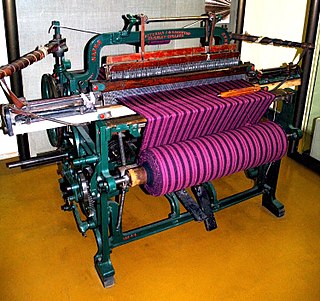
A loom is a device used to weave cloth and tapestry. The basic purpose of any loom is to hold the warp threads under tension to facilitate the interweaving of the weft threads. The precise shape of the loom and its mechanics may vary, but the basic function is the same.

A textile is a flexible material made by creating an interlocking network of yarns or threads, which are produced by spinning raw fibres into long and twisted lengths. Textiles are then formed by weaving, knitting, crocheting, knotting, tatting, felting, bonding or braiding these yarns together.
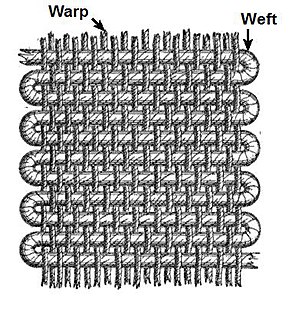
Weaving is a method of textile production in which two distinct sets of yarns or threads are interlaced at right angles to form a fabric or cloth. Other methods are knitting, crocheting, felting, and braiding or plaiting. The longitudinal threads are called the warp and the lateral threads are the weft, woof, or filling. The method in which these threads are inter-woven affects the characteristics of the cloth. Cloth is usually woven on a loom, a device that holds the warp threads in place while filling threads are woven through them. A fabric band which meets this definition of cloth can also be made using other methods, including tablet weaving, back strap loom, or other techniques without looms.
This timeline of clothing and textiles technology covers the events of fiber and flexible woven material worn on the body; including making, modification, usage, and knowledge of tools, machines, techniques, crafts, and manufacturing systems (technology).
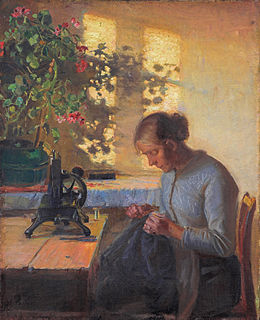
Sewing is the craft of fastening or attaching objects using stitches made with a needle and thread. Sewing is one of the oldest of the textile arts, arising in the Paleolithic era. Before the invention of spinning yarn or weaving fabric, archaeologists believe Stone Age people across Europe and Asia sewed fur and skin clothing using bone, antler or ivory needles and "thread" made of various animal body parts including sinew, catgut, and veins.
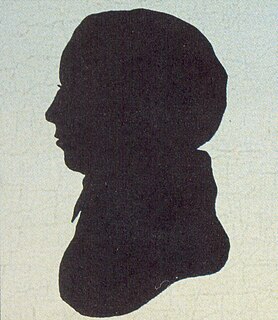
Francis Cabot Lowell was an American businessman for whom the city of Lowell, Massachusetts, is named. He was instrumental in bringing the Industrial Revolution to the United States.
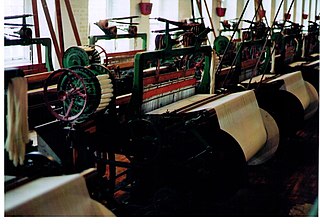
A power loom is a mechanized loom, and was one of the key developments in the industrialization of weaving during the early Industrial Revolution. The first power loom was designed in 1786 by Edmund Cartwright and first built that same year. It was refined over the next 47 years until a design by the Howard and Bullough company made the operation completely automatic. This device was designed in 1834 by James Bullough and William Kenworthy, and was named the Lancashire loom.
Ikat is a dyeing technique originated from Indonesia used to pattern textiles that employs resist dyeing on the yarns prior to dyeing and weaving the fabric.
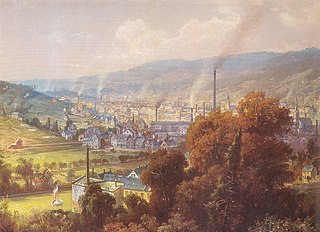
Textile manufacture during the Industrial Revolution in Britain was centred in south Lancashire and the towns on both sides of the Pennines. In Germany it was concentrated in the Wupper Valley, Ruhr Region and Upper Silesia, in Spain it was concentrated in Catalonia while in the United States it was in New England. The main key drivers of the Industrial Revolution were textile manufacturing, iron founding, steam power, oil drilling, the discovery of electricity and its many industrial applications, the telegraph and many others. Railroads, steam boats, the telegraph and other innovations massively increased worker productivity and raised standards of living by greatly reducing time spent during travel, transportation and communications.

The textile industry is primarily concerned with the design, production and distribution of yarn, cloth and clothing. The raw material may be natural, or synthetic using products of the chemical industry.

The Boston Manufacturing Company was a business that operated one of the first factories in America. It was organized in 1813 by Francis Cabot Lowell, a wealthy Boston merchant, in partnership with a group of investors later known as The Boston Associates, for the manufacture of cotton textiles. It built the first integrated spinning and weaving factory in the world at Waltham, Massachusetts, using water power. They used plans for a power loom that he smuggled out of England as well as trade secrets from the earlier horse-powered Beverly Cotton Manufactory, of Beverly, Massachusetts, of 1788. This was the largest factory in the U.S., with a workforce of about 300. It was a very efficient, highly profitable mill that, with the aid of the Tariff of 1816, competed effectively with British textiles at a time when many smaller operations were being forced out of business. While the Rhode Island System that followed was famously employed by Samuel Slater, the Boston Associates improved upon it with the "Waltham System". The idea was successfully copied at Lowell, Massachusetts, and elsewhere in New England. Many rural towns now had their own textile mills.
The Museum of Technology and Textile Industry - a branch of the Museum in Bielsko-Biała, Poland - was founded on January 1, 1979 with the aim of evidencing the traditions of the local wool industry centre by means of collecting machines, devices and documents related to this field of production. Apart from this the Museum also exhibits items connected with firefighting, printing and metal machine industry. The Museum occupies some parts of the Büttners’ former cloth factory, which used to be one of the biggest textile factories in Bielsko.
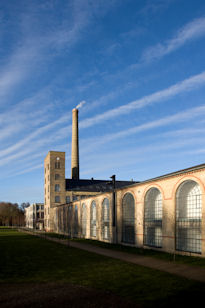
The National Museum of Denmark's new museum, Brede Works, lies in the countryside just north of Copenhagen in Denmark's largest, protected industrial plants. At the museum of Industrial culture, the visitors can be guided around by its own virtual person between old machines, hear how Denmark became an industrial society and even try to work at an assembly line. The exhibitions show the industrial development which has changed the everyday lives of the Danes over the past few centuries.

Trent Mill was a cotton spinning mill on Duchess Street in Shaw and Crompton, Greater Manchester, England. It was built by F.W. Dixon & Son in 1908. It closed and was taken over by the Lancashire Cotton Corporation in 1929 reopened in 1938 and closed again in 1962, and was demolished in 1967.

Queen Street Mill is a former weaving mill in Harle Syke, a suburb to the north-east of Burnley, Lancashire, that is a Grade I listed building. It was built in 1894 for the Queen Street Manufacturing Company. It closed on 12 March 1982 and was mothballed, but was subsequently taken over by Burnley Borough Council and maintained as a museum. In the 1990s ownership passed to Lancashire Museums. Unique in being the world's only surviving operational steam-driven weaving shed, it received an Engineering Heritage Award in November 2010.

Poudreries Réunies de Belgique SA was one of Belgium's oldest and largest manufacturers of munitions, once the second-largest Belgium armaments manufacturer. The company indirectly started in 1778 in Wetteren as a gunpowder factory. By its 200th anniversary in 1979 it had 73 factories throughout the world, with the headquarters in Brussels.
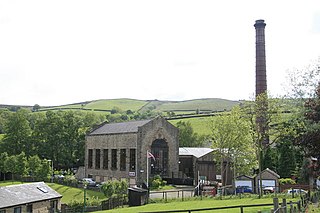
Bancroft Shed was a weaving shed in Barnoldswick, Lancashire, England, situated on the road to Skipton. Construction was started in 1914 and the shed was commissioned in 1920 for James Nutter & Sons Limited. The mill closed on 22 December 1978 and was demolished. The engine house, chimneys and boilers have been preserved and maintained as a working steam museum. The mill was the last steam-driven weaving shed to be constructed and the last to close.

The Groz-Beckert KG is part of the Groz-Beckert Group based in Albstadt-Ebingen in Baden-Wuerttemberg, Germany. Groz-Beckert is the world's leading provider of industrial needles, precision components and fine tools as well as systems and services for the production and joining of textiles. Founded in 1852, the company is still family-owned. On 31 December 2020 the group of companies had around 9,000 employees, of which 2,241 worked at the headquarters in Albstadt. Groz-Beckert is the largest employer of the Zollernalbkreis. In the business year 2020 the company generated a turnover of 618 mil. Euro.
An air-jet loom is a shuttleless loom that uses a jet of air to propel the weft yarn through the warp shed. It is one of two types of fluid-jet looms, the other being a water-jet loom, which was developed previously. Fluid-jet looms can operate at a faster speed than predecessor looms such as rapier looms, but they are not as common. The machinery used in fluid-jet weaving consists of a main nozzle, auxiliary nozzles or relay nozzles, and a profile reed.















